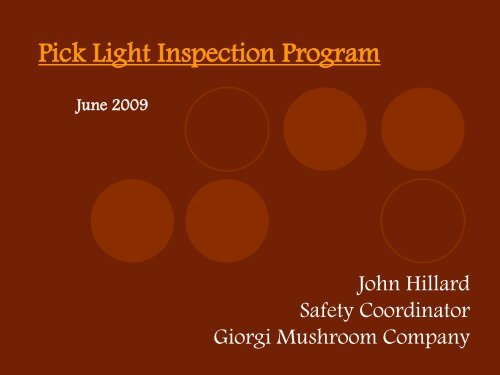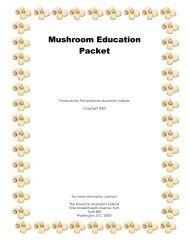Pick Light Inspection Program - The American Mushroom Institute
Pick Light Inspection Program - The American Mushroom Institute
Pick Light Inspection Program - The American Mushroom Institute
You also want an ePaper? Increase the reach of your titles
YUMPU automatically turns print PDFs into web optimized ePapers that Google loves.
<strong>Pick</strong> <strong>Light</strong> <strong>Inspection</strong> <strong>Program</strong><br />
June 2009<br />
John Hillard<br />
Safety Coordinator<br />
Giorgi <strong>Mushroom</strong> Company
<strong>Pick</strong> <strong>Light</strong> <strong>Inspection</strong> <strong>Program</strong><br />
Introduction<br />
- Any light that is not approved by a national electrical<br />
listing organization (i.e. UL or ETL) is not considered<br />
legal. In other words no homemade lights.<br />
- <strong>The</strong>re is at least one pick light and one fixed room<br />
light on the market, at this point, that is approved by<br />
one of the approved listing organizations.<br />
- <strong>Inspection</strong> programs should replace ‘non-approved’<br />
lights with the new ‘approved’ lights
<strong>Pick</strong> <strong>Light</strong> <strong>Inspection</strong> <strong>Program</strong><br />
Our Focus Today<br />
1.) Financial benefits of replacing old lights with the<br />
new ‘approved’ lights.<br />
2.) Common hazards with all pick lights.<br />
3.) Inspecting<br />
4.) <strong>Inspection</strong> recordkeeping
<strong>Pick</strong> <strong>Light</strong> <strong>Inspection</strong> <strong>Program</strong><br />
Financial Benefits<br />
1.) Repairing and maintaining lights takes time<br />
- Time to inspect<br />
- Time to repair<br />
2.) ‘Approved’ lights are more efficient<br />
3.) ‘Approved’ lights are the safer solution
<strong>Pick</strong> <strong>Light</strong> <strong>Inspection</strong> <strong>Program</strong><br />
Repair and Maintenance Cost Areas<br />
1.) <strong>Light</strong> <strong>Inspection</strong>s for ‘approved’ & ‘non-approved’<br />
- 1 Hour per 10 lights bi-annually<br />
2.) ‘Non-approved’ <strong>Light</strong> Repairs<br />
- Simple repairs could take 15 minutes<br />
- Extensive repairs could take over 1 hour<br />
3.) ‘Approved’ <strong>Light</strong> Repairs<br />
- Should never take over 30 minutes<br />
- However, you must use the vendors original parts
<strong>Pick</strong> <strong>Light</strong> <strong>Inspection</strong> <strong>Program</strong><br />
<strong>Light</strong> Efficiency<br />
‘Approved <strong>Light</strong>’ v. ‘Non-Approved <strong>Light</strong>’:<br />
1.) ‘Approved’ light uses a more efficient Electronic<br />
Ballasts.<br />
2.) ‘Approved’ light uses a more efficient T-5 bulb<br />
3.) ‘Approved’ light produces a higher lumen output<br />
which means less lights per room.
<strong>Pick</strong> <strong>Light</strong> <strong>Inspection</strong> <strong>Program</strong><br />
<strong>The</strong> Safer Solution<br />
1.) Using a ‘approved’ light is the safest option.<br />
2.) How does being safe save me money?<br />
If you have any electrical shock injury:<br />
- Average direct cost from a electrical shock injury is<br />
$ 86,448 according to OSHA’s website<br />
- Using a 3% profit margin, it will take about 2.9 million<br />
dollars in sales to make up the loss caused by the direct costs.<br />
- This figure does not factor in the indirect costs which could<br />
potentially double the numbers
<strong>Pick</strong> <strong>Light</strong> <strong>Inspection</strong> <strong>Program</strong><br />
Common Hazards<br />
1.) Ungrounded Circuits in the double.<br />
2.) Loss of ‘water-tightness’<br />
3.) Damaged insulation<br />
4.) Damaged plugs<br />
5.) Damaged receptacles<br />
6.) <strong>Light</strong>s constructed with metal components and<br />
hardware.
<strong>Pick</strong> <strong>Light</strong> <strong>Inspection</strong> <strong>Program</strong><br />
Ungrounded Circuits<br />
1.) Provide no protection<br />
2.) Removing or not using the ground is like<br />
removing a guard on a table saw.<br />
Loss of water tightness<br />
1.) Allows current to pass where it should not pass<br />
2.) Creates a electrocution hazard.
<strong>Pick</strong> <strong>Light</strong> <strong>Inspection</strong> <strong>Program</strong><br />
Damaged Insulation
<strong>Pick</strong> <strong>Light</strong> <strong>Inspection</strong> <strong>Program</strong><br />
Damaged Insulation
<strong>Pick</strong> <strong>Light</strong> <strong>Inspection</strong> <strong>Program</strong><br />
Damaged Insulation
<strong>Pick</strong> <strong>Light</strong> <strong>Inspection</strong> <strong>Program</strong><br />
Damaged Plugs
<strong>Pick</strong> <strong>Light</strong> <strong>Inspection</strong> <strong>Program</strong><br />
Damaged Plugs
<strong>Pick</strong> <strong>Light</strong> <strong>Inspection</strong> <strong>Program</strong><br />
Damaged Receptacles
<strong>Pick</strong> <strong>Light</strong> <strong>Inspection</strong> <strong>Program</strong><br />
Damaged Receptacles
<strong>Pick</strong> <strong>Light</strong> <strong>Inspection</strong> <strong>Program</strong><br />
Damaged Receptacles
<strong>Pick</strong> <strong>Light</strong> <strong>Inspection</strong> <strong>Program</strong><br />
<strong>Light</strong>s Constructed with Metal<br />
1.) Metal is conductive<br />
2.) Wiring issues (in the double and in the light itself)<br />
may cause light to become energized.<br />
3.) Combined with a frequently wet area metal parts<br />
creates a large hazard
<strong>Pick</strong> <strong>Light</strong> <strong>Inspection</strong> <strong>Program</strong><br />
Inspecting<br />
1.) Who should do this<br />
2.) Frequency of inspection<br />
3.) Cord inspection<br />
4.) <strong>Light</strong> body inspection<br />
5.) Ground inspection
<strong>Pick</strong> <strong>Light</strong> <strong>Inspection</strong> <strong>Program</strong><br />
Who?:<br />
1.) <strong>The</strong> quick visual inspection could be done by<br />
anyone who had received a short training.<br />
2.) <strong>The</strong> complete inspections should be done by a<br />
trained and qualified person<br />
3.) Should be extensively trained on what to look for<br />
and how to correctly and safely correct it
<strong>Pick</strong> <strong>Light</strong> <strong>Inspection</strong> <strong>Program</strong><br />
Frequency<br />
1.) <strong>The</strong>re should be a quick visual inspection before<br />
installation to identify major issues.<br />
2.) Full inspection frequency can be determined by<br />
your repair history<br />
3.) Bi-annually is probably a good starting point
<strong>Pick</strong> <strong>Light</strong> <strong>Inspection</strong> <strong>Program</strong><br />
Example:<br />
2009 2009 2009 2009 2009 2009<br />
Jan. Feb. Mar. Apr. May Jun.<br />
Start<br />
2009 2009 2009 2009 2009 2009<br />
Jul. Aug. Sep. Oct. Nov. Dec.<br />
Expire 7/30/2009<br />
Start<br />
2010 2010 2010 2010 2010 2010<br />
Jan. Feb. Mar. Apr. May Jun.<br />
Start<br />
Expire 1/30/2010
<strong>Pick</strong> <strong>Light</strong> <strong>Inspection</strong> <strong>Program</strong><br />
Cord <strong>Inspection</strong><br />
Identify :<br />
1.) Cuts or holes in the cord<br />
2.) Broken or bent prongs on the plug<br />
3.) Bunched up insulation<br />
4.) Bad connections between light and cord or<br />
cord and plug
<strong>Pick</strong> <strong>Light</strong> <strong>Inspection</strong> <strong>Program</strong><br />
<strong>Light</strong> Body <strong>Inspection</strong><br />
1.) Physical Damage to the housing<br />
2.) Unsealed joints<br />
3.) Removed caulk or sealant<br />
4.) Missing Fasteners
<strong>Pick</strong> <strong>Light</strong> <strong>Inspection</strong> <strong>Program</strong><br />
Ground <strong>Inspection</strong><br />
1.) Insure ground prong is intact on plug<br />
2.) Check conductivity of the cord<br />
3.) Check the connection between the ground prong<br />
and the ballast
<strong>Pick</strong> <strong>Light</strong> <strong>Inspection</strong> <strong>Program</strong><br />
<strong>Inspection</strong> Recordkeeping<br />
1.) Shows you are making an effort to be safe<br />
2.) Helps you track and trend repairs<br />
3.) Using a recordkeeping program in conjunction<br />
with a sticker system is an easy way to ensure<br />
all lights are being checked
<strong>Pick</strong> <strong>Light</strong> <strong>Inspection</strong> <strong>Program</strong><br />
Example Logbook<br />
<strong>Light</strong> # Date<br />
0001<br />
0002<br />
0003<br />
0004<br />
Inspected By<br />
(Initials)<br />
6/15/09 JSH<br />
Notes<br />
Ballast and Bulb<br />
Changed<br />
6/15/09 JSH Bulb Changed<br />
6/15/09 JSH OK<br />
6/15/09 JSH Plug Changed
<strong>Pick</strong> <strong>Light</strong> <strong>Inspection</strong> <strong>Program</strong><br />
Conclusion<br />
1.) Priority #1 should be replacing the ‘non-<br />
approved’ with ‘approved’ lights<br />
2.) <strong>Inspection</strong>s decrease risk employee injury and<br />
should be done on both ‘non-approved’ and<br />
‘approved’ lights<br />
3.) Email me if you would like blank templates of the<br />
examples you have seen today.
Thank You




